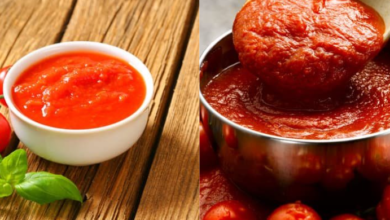Tomato Puree Vs Fresh Tomatoes: Which One Is Better?
What To Know
- Fresh tomatoes are a rich source of vitamins and minerals, including vitamin C, potassium, and lycopene, an antioxidant linked to numerous health benefits.
- Tomato puree, on the other hand, has a concentrated and intense flavor, with a more pronounced sweetness and less acidity.
- However, it is important to adjust the amount used to account for the concentrated flavor of tomato puree.
Tomato puree and fresh tomatoes are both versatile ingredients that hold a prominent place in cuisines worldwide. While they share a common base, they offer distinct characteristics that can impact the flavor, texture, and nutritional value of dishes. Understanding the differences between tomato puree vs fresh tomatoes is crucial for culinary enthusiasts seeking to elevate their cooking skills.
Nutritional Value
Fresh tomatoes are a rich source of vitamins and minerals, including vitamin C, potassium, and lycopene, an antioxidant linked to numerous health benefits. Tomato puree, while made from fresh tomatoes, undergoes a concentration process that reduces its water content and increases its nutrient density. As a result, tomato puree contains higher levels of lycopene and other antioxidants compared to fresh tomatoes.
Flavor and Aroma
Fresh tomatoes possess a complex flavor profile that varies depending on the variety and ripeness. They offer a balance of sweetness, acidity, and umami, with a vibrant and fresh aroma. Tomato puree, on the other hand, has a concentrated and intense flavor, with a more pronounced sweetness and less acidity. The aroma of tomato puree is also less pronounced than that of fresh tomatoes.
Texture
Fresh tomatoes have a juicy and tender texture that adds moisture and bulk to dishes. They can be sliced, diced, or pureed to create a variety of textures. Tomato puree, in contrast, has a thick and smooth consistency, making it ideal for thickening sauces, soups, and stews. It does not add any significant texture to dishes.
Convenience and Shelf Life
Fresh tomatoes require refrigeration and have a limited shelf life. They need to be consumed within a few days of purchase to maintain their freshness and flavor. Tomato puree, on the other hand, has a much longer shelf life due to its concentrated form. It can be stored in the pantry for several months without compromising its quality.
Cost
Fresh tomatoes are generally more affordable than tomato puree, especially when in season. However, the cost of fresh tomatoes can fluctuate depending on availability and quality. Tomato puree, while more expensive per unit, offers a concentrated form that can yield a greater amount of flavor and nutrients.
Culinary Applications
Fresh tomatoes are versatile ingredients that can be used in a wide variety of dishes, including salads, sandwiches, pizzas, and pasta sauces. They add flavor, color, and texture to dishes. Tomato puree is primarily used as a base for sauces, soups, and stews. It adds richness, depth of flavor, and color to dishes without the need for additional ingredients.
Which to Choose?
The choice between tomato puree vs fresh tomatoes depends on the specific dish and the desired result. For dishes where fresh, vibrant flavor and texture are paramount, fresh tomatoes are the better option. For dishes that require a concentrated, rich flavor and thickening agent, tomato puree is the preferred choice.
Conclusion: Enhancing Culinary Versatility
Understanding the differences between tomato puree vs fresh tomatoes empowers culinary enthusiasts to make informed decisions about which ingredient to use in their dishes. By leveraging the unique characteristics of each form, chefs can create flavorful and visually appealing meals that cater to a range of palates.
FAQ
1. Can I substitute tomato puree for fresh tomatoes in all recipes?
Yes, in most recipes, tomato puree can be substituted for fresh tomatoes. However, it is important to adjust the amount used to account for the concentrated flavor of tomato puree.
2. How do I make tomato puree from fresh tomatoes?
To make tomato puree from fresh tomatoes, simply puree them using a food processor or blender. You can also remove the seeds and skins for a smoother consistency.
3. What is the difference between tomato paste and tomato puree?
Tomato paste is even more concentrated than tomato puree, with a thicker consistency and a deeper, more intense flavor. It is used in small amounts to add a burst of flavor to dishes.
